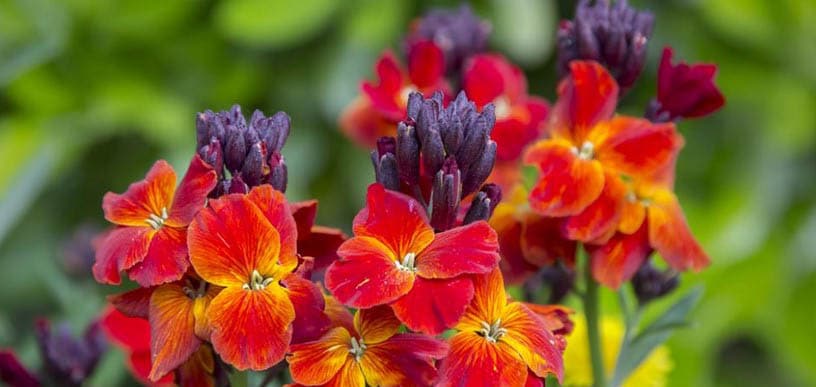When to sow the wallflowers?
If you buy the wallflowers in buckets, you will plant them in autumn, so they bloom late in the winter or early in the spring.
If you sow them with commercial seeds that have already been treated and have been cold-induced, called vernalization, you can put them in place directly between May and July. They then bloom the following spring.
Which varieties to choose?
From the Erysimum cheiri species, many cultivars and hybrids have been created which vary with flowering time, size and flower color.
Most often in the trade the seeds are sold in the form of mixture of different varieties.
Varieties with multiple colors:
The Aida it gives cream, carmine, scarlet or golden yellow flowers. The plant is perfectly branched and has a height of 35 cm. It is particularly intended for terraces, massifs and rockeries. It is hardy and resistant to temperatures of -15 ° C.
Charity : this variety blooms in very fragrant plants from the beginning of autumn. Its flowers are of different colors: yellow, old pink, scarlet, red or cream. They are fairly compact plants that are 25 cm tall. It is hardy until -15 ° C. It is perfect for terraces, beds or rock gardens, it does not need cold to start blooming.
Bedder : this variety gives small yellow, brown, orange, red flowers, between March and June. It grows in an erect and compact form of 35 cm in height. Its foliage is evergreen, it is hardy up to -15 ° C, and it is suitable for rock gardens, terraces and beds.
Royal : is a variety that comes in the form of 6 very bright colors that brighten your garden. It has a height of 30 cm, it is perfect for rock gardens, beds or terraces and supports temperatures up to -15 ° C.
Sugar Rush F1 : its flowers are yellow, golden yellow, bronze, red or mixed. It flowers between October and friend and it gives off a pleasant scent. What characterizes it is its growth and the fact that its flowers grow quickly since 2.5 months are sufficient. It is about 28 cm high. She does not need cold to bloom, she likes in massifs, in rock gardens and on the terrace. It can withstand low temperatures down to -15 ° C.
The varieties with red flowers:
Dresden brunette : it gives flowers of a beautiful deep red, and it measures 30 cm in height. It flourishes in rock gardens, on the terrace or in beds and it withstands temperatures down to -15 ° C.
Small varieties:
Tom Thumb : its flower is yellow, it has a small size and it is bushy. She loves rock gardens, terraces or beds and is able to withstand low temperatures down to -15 ° C.
Gnome : this dwarf and branched variety gives yellow flowers. She likes hotpot, massive, rocky. It holds up to -15 ° C.
Large varieties:
Scarlet Imperator : its flowers are of a fiery red hue. It has a large size of 45 to 60 cm and supports low temperatures down to -15 ° C. It is perfect in bouquet, but it is also suitable for massive and rock gardens.
Goliath : is in the form of brown flowers that culminate at 45 cm or even 60 cm. She makes very pretty bouquets, she is rustic until -15 ° C.
Cloth of Gold : this variety gives large golden yellow flowers since they can measure from 45 to 60 cm high. This is what makes it perfect bouquet. It grows in massifs, in rock gardens and on the terrace and it resists up to -15 ° C.
Fire King it gives pretty orange-red flowers that last a very long time. It has a size of 45 to 60 cm and is hardy to -15 ° C. It is suitable for terraces, beds and rock gardens.
What to do before sowing the wallflowers?
Prepare your soil well: you have to turn the soil upside down and eliminate all the weeds, stones or roots that would prevent the plant from making beautiful roots.
Also, if the soil is wet, add sand to ensure better drainage and to keep it cooler.
How to sow them?
Plant the wallflowers:
You can perfectly buy plants of wallflowers in gardening.
- Just make a hole and put the plant in the middle and then cover it with soil.
- Then, it must be watered regularly for a few weeks without abusing.
- When planting, it is useless to enrich in fertilizer or compost.
Sowing the wallflower:
You can perfectly sow the wallflowers as early as March in terrine and sheltering it properly. You can then transplant them in pots in May and put them in the ground in September. They will then bloom in the spring after.
The root system is quite fragile, transplanting is not always appreciated by this plant.
Instead, prefer sowing on site during the period of May to July. Proceeding in this way:
- On a soil that you have already prepared: sow the seeds on the fly.
- Then lightly tamp the earth with a shovel or the back of the rake.
- Water very regularly until the seedlings rise. Subsequently, water only when the soil is dry.
- As soon as the plants have some leaves, you can proceed with the lightening of the plants. They should be spaced about 30 cm apart to develop properly.
- Flowering will begin in the spring after at most.
Multiply the wallflower:
Propagation by seed is possible, but in the case of some cultivars, it is better to use cuttings to obtain identical plants, this is the only solution.
Propagation by seed
It is possible to let the plants reseed spontaneously by keeping them on the spot simply. In this case, the new plants may be different from the mother plant.
You also have the opportunity to harvest the seeds of wallflower when the fruit looks a bit like a dry pod and begins to open, usually at the end of summer.
Then you let them dry properly and then you put them in an airtight plastic box or a freezer bag. Then place them in the refrigerator for 2 to 3 months to undergo the vernalization, action of the cold. You can then sow them in pots or in the ground.
Propagation by cuttings
- At the end of the summer, cut the flower stalks to put them to end.
- Remove the ends of the twigs when they have been de-skirted for about 15 cm and remove the withered flowers. Keep only two leaves per twig.
- Plant them 2/3 in a light and draining substrate composed of subsoil and 2/3 of sand.
- It is also possible to place the cutting directly in the ground. If you do this, put several cuttings in the same place. Then, once the plant has resumed, you will keep only two per location.
- Water regularly until the plants are large enough.
Where to plant the wallflowers?

You will enjoy this flower by planting it in the garden where you can not grow anything. Indeed, it adapts perfectly poor and dry soils, its only requirement: that it be well drained.
It also integrates very well with the massifs from the moment it is composed of other perennials. However, it is best to select a location that is sunny enough to promote flowering, the wallflower enjoying the sun.
You can also grow it in pots or planters. In this case, choose a good potting soil and mix with coarse sand to ensure drainage.
How to maintain them?
The wallflower does not require much maintenance, however some gestures are necessary for them to be perfectly beautiful:
Cut flower stalks as soon as they are faded to stimulate regrowth and prolong flowering. Leave only a few shafts to get it back on its own thanks to the wind.
Straw the soil, so it will stay cool and the plant will evolve in good conditions.
Protections during the winter are not necessary, they support very low temperatures since they resist up to at least -15 ° C.
To know : from the third year, the flowering and the port of the plants which you left in place begin to deteriorate, it is for this reason that it is interesting to practice the multiplication.
Size : it is not obligatory. It should be noted however that if you regularly cut faded flowers, you stimulate all the more flowering. If you close the plants a third after flowering, you will get a more compact port.
How to water the wallflowers?
The wallflowers are pleasant on well-drained soils and they only water when they are in bloom.
The diseases of the wallflowers and what to do?
The wallflower is quite insensitive to diseases, however in certain climatic circumstances, some may appear. :
Rust : the wallflower undergoes rust attacks, especially during the spring to autumn period, when these seasons are particularly wet. You spot it because it pigments the leaves. Small yellow-brown spots then appear and the plants are weakened. You must remove the affected parts and spray a nettle manure.
Mildew : it can manifest on foliage when summer and very hot and stormy. You then see large yellow or brown spots that cause desiccation, then the fall of the leaves. The plant needs excellent drainage to avoid this problem and you should not water in quantity.
On the harmful side, the wallflowers attract mainly snails and slugs who are fond of it. You can pick them up regularly, but also set them traps with beer.
Plant other flowers:








